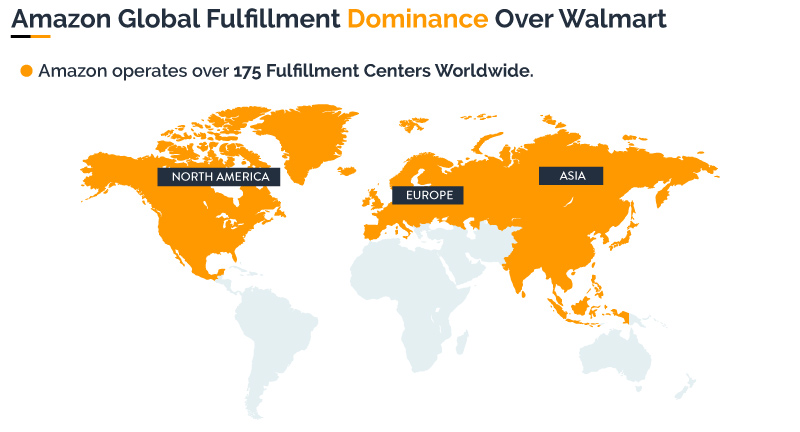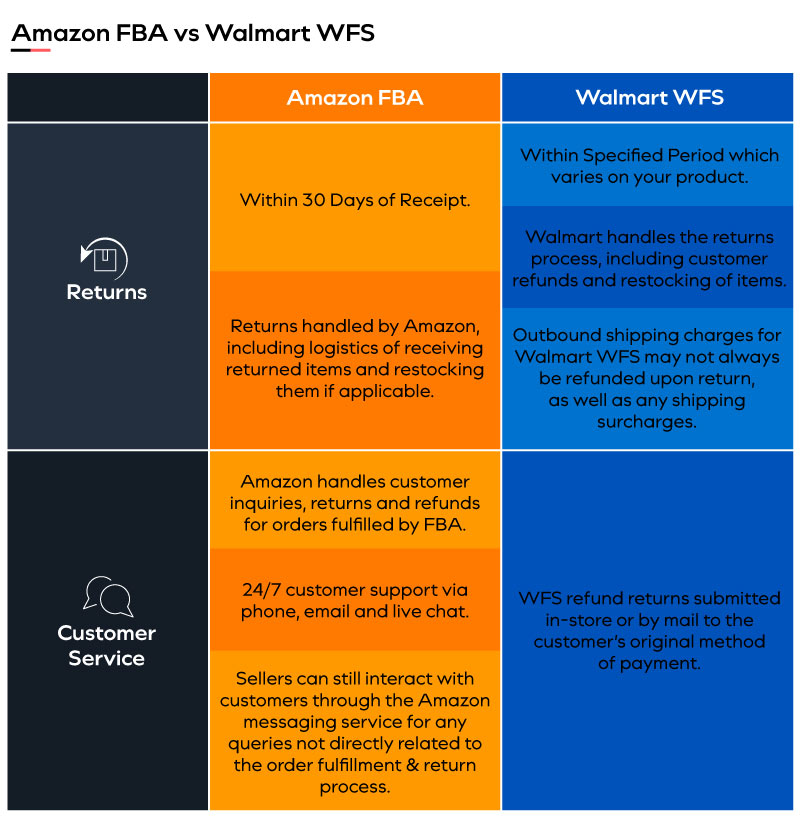
Amazon FBA (Fulfillment by Amazon) and Walmart WFS (Walmart Fulfillment Services) are both e-commerce fulfillment services that handle packing, shipping, customer service, and returns for those products.
Amazon FBA
Amazon FBA offers a vast global reach and a larger customer base.
Individual Sellers: Pay a $0.99 fee per item sold
Professional Sellers: Monthly subscription fee of $39.99.
Refund Administration Fees: $5.00 or 20% of the refunded charge.
Fulfillment Fees: Start at $3.22 per unit up to $200+ for specific, oversized items.
Storage Fees: For standard-size items, fees will decrease from $0.87 to $0.78 per cubic foot.
Aged Inventory Surcharge: Increases for inventory stored between 271-365 days
Amazon FBA inventory is managed through Amazon Seller Central
Products fulfilled by Amazon are eligible for Amazon Prime. This means free 2-Day shipping, and even Same-Day Delivery in eligible areas.
Amazon handles customer service, returns, and refunds for orders fulfilled by FBA. Sellers can monitor inventory levels, track shipments, and view customer orders through Seller Central.
Walmart WFS
Walmart's WFS (Walmart Fulfillment Services) provides access to Walmart's U.S. market.
Fulfillment Fees: Base fee starts at $3.45 for items weighing ≤ 1 lb.
Storage Fees: $0.75 per cubic foot per month; increase to $1.50 per cubic foot/month for items stored more than 30 days during Oct. to Dec. For items stored over 12 months, the fee can go up to $7.50 per cubic foot per month.
Other Charges: Include fees for problem inventory, return shipping & exceptions, and disposal & removal based on weight and size
Walmart WFS inventory is managed through Walmart Seller Center
Products fulfilled by WFS are eligible for 2-day delivery program
Walmart handles customer service inquiries, returns, and refunds for items sold through WFS. Sellers have access to a dashboard for tracking inventory, orders, and returns.
However, not all sellers have great experiences using Amazon FBA and Walmart fulfillment services for their ecommerce business. A Reddit user who sells products through Amazon FBA program had problems with Amazon mishandling their inventory. This caused damage and labeling errors. With Walmart Fulfillment Services, a seller also shared on Reddit a bad experience with lost inventory and a complex dispute process. It involved a lot of paperwork and inefficiencies in inventory management and seller support within WFS's system.
In this article, we will share in-depth information on the comparison between Walmart WFS vs Amazon FBA and what is the best option for your E-commerce business. We will also explore how local lead generation has more to offer for any E-commerce business.
Key Differences Between Amazon FBA and Walmart WFS for E-commerce
1. Amazon's Global Fulfillment Dominance Over Walmart WFS Domestic Presence

Amazon operates over 175 fulfillment centers worldwide, with presence in North America, Europe, and Asia. This global reach allows sellers to easily access international markets. According to Yaguara, among the 9.7 million Amazon sellers worldwide, 94% leverage Amazon FBA services.
On the other hand, Walmart successfully launched its own fulfillment services in 2020. However, only 38% of Walmart sellers use WFS, according to Jungle Scout. This implies that Amazon has already established its fulfillment services and has a wider reach of sellers over Walmart WFS.
2. Cost-effectiveness of Walmart WFS Fees and Cost Structure Over Amazon FBA
Amazon FBA

Amazon FBA Seller Fees
Fulfillment and Shipping Fees


Storage Fees


Additional Service Fees
Walmart WFS



3. Walmart WFS Has a Simpler System for Inventory than Amazon FBA
Amazon FBA inventory management involves several process. These include:
On the other hand, Walmart WFS inventory management involves:
4. Amazon FBA Shipping and Delivery Option Over Walmart WFS Local Shipment
Amazon FBA offers international shipping options to fulfill orders internationally. On the other hand, Walmart WFS provide coverage within the U.S. WFS also strives to offer swift shipping, including a 2-day delivery choice throughout U.S.
5. Amazon FBA offers Streamlined Returns and Customer Service than Walmart WFS

Returns
Customer Service
Key Takeaways
Is it Better to Use the Fulfillment Services of Amazon or Walmart for Your Business?
It's better to use the fulfillment services of Amazon for your business if your business targets a global market. In contrast, it's better to use the fulfillment services of Walmart for your business if you are concerned about competitive pricing and cost-effectiveness.
According to Gitnux, Amazon FBA sellers typically see a sales boost of around 30-50% upon joining the program. This means that businesses using Amazon's fulfillment services experience significant growth in their sales volume. The data suggests that Amazon FBA significantly boosts sales for sellers, likely due to Amazon's vast customer base and trust in the platform.
On the other hand, Walmart has been expanding its online marketplace and fulfillment services, appealing to businesses that want to tap into Walmart’s large, loyal customer base.
According to Lab916, Walmart's sales soared, beginning at 35% in January 2019, mainly because of its cheaper and clearer pricing compared to Amazon FBA. Over time, Walmart's online sales grew consistently, surpassing Amazon FBA by more than 10%. Notably, Walmart's Fulfillment Services saw a huge 42.8% increase in Ecommerce sales.
Can You Use Amazon FBA and Walmart WFS Simultaneously?
Yes, you can use Amazon FBA and Walmart WFS simultaneously, but it requires careful management. Each platform has its own set of rules, fees, and logistics. Sellers can leverage both platforms to maximize their online presence and reach different customer bases. However, it's important to keep inventory and order management systems well-organized to ensure smooth operations across both platforms. This strategy allows sellers to diversify their sales channels and reduce dependence on a single marketplace, potentially increasing their overall sales and market penetration.
How Competitive is Amazon FBA and Walmart WFS?

Amazon FBA and Walmart WFS are highly competitive. According to the Ecommerce coach Dan Rodgers of Just One Dime, he highlights the competition level of Amazon and Walmart marketplace. Walmart Marketplace has lower competition with 130,000 active sellers compared to Amazon's 1.1 – 1.5 million active sellers in the US. This is further illustrated by significantly lower review counts on Walmart, suggesting a less saturated market.

However, a post on X finds it funny that people think Amazon Wholesale FBA is very competitive. The user believes success is more about finding the right products to sell than beating competitors.
What are the Challenges of Sellers on Amazon FBA and Walmart WFS?

The Reddit post highlights several challenges faced by sellers on Walmart's platform compared to Amazon FBA (Fulfillment by Amazon). The user prefers Amazon because it's more transparent than Walmart, which seems to make decisions without clear reasons. Walmart's practices include withholding payments for extended periods without explanation. As a result, this automatically deactivate listings without valid reasons. They also have problematic return policy that makes it difficult for sellers to receive refunds for incorrect items.
Customer service from Walmart is also criticized for being unhelpful and ineffective. They have overseas representatives unable to resolve issues . Additionally, reimbursement for damaged or used items is capped at a maximum of 20% of the total price. This is lower compared to Amazon's policies.
Furthermore, the post suggests that Walmart's search algorithm prioritizes Walmart's own items over third-party sellers' products. This is challenging for sellers to gain visibility on the platform. These challenges highlights difficulties faced by sellers on both Amazon FBA and Walmart WFS. But with a particular emphasis on the lack of support, unclear policies, and search visibility issues on Walmart's platform.

The Reddit post emphasizes the importance of avoiding failure in business dealings, particularly with suppliers. The author shares their own challenging experiences with suppliers and the potential risks involved. The user suggests that sellers must opt for a third-party inspection of their goods before shipment from the supplier's factory. This step is crucial for mitigating risks associated with receiving defective products. They emphasize that even if the inspection reveals issues, it's a better outcome compared to receiving and paying for a large quantity of faulty goods.
Beyond Amazon FBA and Walmart WFS: Why Local Lead Generation is the Best Option Than an Ecommerce Business
Local lead generation is the best option than an ecommerce businesses because it’s practical. By focusing on building and ranking a website targeted at in a local market, businesses can avoid the complexity of large-scale fulfillment systems. Instead of competing on a global level, you can zero in on your local audience and start generating high-quality leads. Once the leads are generated, the process becomes much simpler and direct.
One of the most attractive aspects of local lead generation is the potential to "rent and rank" your digital property for profit. After setting up and ranking your websites to produce consistent leads, you can partner with local business owners who will pay for these leads. Plus, you remain in control of your entire lead generation process. This allows you to manage how many sites you build and what markets or niches you target.

In summary, local lead generation offers local businesses a streamlined way to target their markets while also providing an opportunity to generate passive income. The simplicity and profitability of this model make it an appealing option for anyone looking to scale their online presence without excessive complexity.






